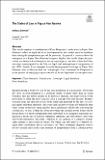Files in this item
The states of law in Papua New Guinea
Item metadata
| dc.contributor.author | Demian, Melissa Aviva | |
| dc.date.accessioned | 2021-08-05T15:30:06Z | |
| dc.date.available | 2021-08-05T15:30:06Z | |
| dc.date.issued | 2021-08-05 | |
| dc.identifier | 274933775 | |
| dc.identifier | 2c9fd67f-81b4-4e36-bd74-994ec4a7e2f0 | |
| dc.identifier | 85111934684 | |
| dc.identifier | 000681583700001 | |
| dc.identifier.citation | Demian , M A 2021 , ' The states of law in Papua New Guinea ' , Law and Critique , vol. 32 . https://doi.org/10.1007/s10978-021-09300-3 | en |
| dc.identifier.issn | 0957-8536 | |
| dc.identifier.other | ORCID: /0000-0002-1215-0239/work/98197260 | |
| dc.identifier.uri | https://hdl.handle.net/10023/23724 | |
| dc.description.abstract | This article employs a consideration of Peter Fitzpatrick’s early work in Papua New Guinea to reflect on legal and social developments in the country since his residence there during the independence period. In particular, Fitzpatrick’s concerns about the emergence of a Papua New Guinean bourgeois legality that would shape the postcolony are shown to have been prescient in some respects, and also to have had other outcomes unanticipated by the Marxist legal and anthropological imagination of the 1970s. Finally, I use examples from the heterogeneous lawscape of Papua New Guinean cities to illustrate how the ‘true people’s law’ envisioned by Fitzpatrick is in the process of emerging in spaces outside of formal legislative or court processes. | |
| dc.format.extent | 14 | |
| dc.format.extent | 475571 | |
| dc.language.iso | eng | |
| dc.relation.ispartof | Law and Critique | en |
| dc.subject | Postcolonialism | en |
| dc.subject | Class formation | en |
| dc.subject | Legal pluralism | en |
| dc.subject | Jurisdiction | en |
| dc.subject | Lawscape | en |
| dc.subject | GN Anthropology | en |
| dc.subject | JZ International relations | en |
| dc.subject | T-NDAS | en |
| dc.subject.lcc | GN | en |
| dc.subject.lcc | JZ | en |
| dc.title | The states of law in Papua New Guinea | en |
| dc.type | Journal article | en |
| dc.contributor.institution | University of St Andrews. Centre for Pacific Studies | en |
| dc.contributor.institution | University of St Andrews. Institute of Legal and Constitutional Research | en |
| dc.contributor.institution | University of St Andrews. Social Anthropology | en |
| dc.identifier.doi | https://doi.org/10.1007/s10978-021-09300-3 | |
| dc.description.status | Peer reviewed | en |
This item appears in the following Collection(s)
Items in the St Andrews Research Repository are protected by copyright, with all rights reserved, unless otherwise indicated.

